Investigation of the Insulation Characteristics of TPU/EP Composites Under Cold Thermal Shock
Abstract
:1. Introduction
2. Material Preparation and Experimental Methods
2.1. Raw Materials and Manufacturers
2.2. Material Preparation
2.3. Testing Methods
3. Test Results
3.1. Main Raw Materials
3.2. Electrical Performance Test Results
3.2.1. Volume Resistivity
3.2.2. Relative Permittivity
3.2.3. Dielectric Loss
3.2.4. Partial Discharge Inception Voltage
3.2.5. Short-Term AC Breakdown Field Strength
3.3. Microscopic Morphology Test Results
3.3.1. Infrared Spectral Test Results
3.3.2. DSC Test Results
3.3.3. Variable-Frequency Impedance Spectroscopy Test Results
3.3.4. Wideband Dielectric Spectroscopy Test Results
3.3.5. SEM Test Results
4. Analysis and Discussion
5. Conclusions
- The incorporation of TPU into EP enhances the composite material’s mechanical properties. Under thermal shock conditions, compared to pure epoxy, the TPU/epoxy composite shows an increase in its elastic modulus of 10.1%, elongation at break of 15.3%, tensile strength of 22.3%, and impact strength of 47.8%.
- Under thermal shock conditions, the TPU/EP composite exhibits an excellent electrical performance. With a 1–6.7 wt% TPU loading, materials subjected to 240 h of thermal cycling show a 10.5% increase in volume resistivity compared to pure epoxy, a 40.2% decrease in relative permittivity, an 85.5% reduction in dielectric loss, a 28.9% increase in partial discharge initiation voltage, and a 52.1% increase in AC breakdown strength.
- The flexible molecular chains of TPU confer enhanced toughness and thermal stability to the material, enabling the TPU/EP composite to maintain a stable electrical performance during operation under fluctuating high and low temperatures. Furthermore, the cross-linked structure within the TPU/EP composite significantly mitigates the degradation of both mechanical and electrical properties when subjected to thermal shock conditions.
Author Contributions
Funding
Institutional Review Board Statement
Informed Consent Statement
Data Availability Statement
Conflicts of Interest
References
- Zhang, C.; Liu, Z.; Zhang, T.; Wang, X.; Yin, C.; Liu, X.; Chi, Q. High-temperature resistance and excellent electrical insulation in EP blends. Phys. Rev J. Appl. Polym. Sci. 2023, 140, e54359. [Google Scholar] [CrossRef]
- Wang, Y.; Zhuo, Z.; Ziye, H.; Jing, S. Preparation and characteristics of silicone-modified aging-resistant epoxy resin insulation material. J Mater Sci. 2022, 57, 3295–3308. [Google Scholar] [CrossRef]
- Mousavi, S.R.; Estaji, S.; Kiaei, H.; Mansourian-Tabaei, M.; Nouranian, S.; Jafari, S.H.; Ruckdäschel, H.; Arjmand, M.; Khonakdar, H.A. A review of electrical and thermal conductivities of epoxy resin systems reinforced with carbon nanotubes and graphene-based nanoparticles. Polym. Test. 2022, 112, 107645. [Google Scholar] [CrossRef]
- Zhao, R.; Li, J.; Chen, Y.; Cui, B.; Teng, Y.; Kong, X.; Du, B. Electrical Treeing Characteristics in Glass Fiber Reinforced Epoxy Resin. In Proceedings of the IEEE 4th International Conference on Dielectrics (ICD 2022), Palermo, Italy, 3–7 July 2022. [Google Scholar] [CrossRef]
- Mousavi, S.R.; Estaji, S.; Rostami, E.; Khonakdar, H.A.; Arjmand, M. Effect of a novel green modification of alumina nanoparticles on the curing kinetics and electrical insulation properties of epoxy composites. Polym. Adv. Technol. 2022, 33, 49–65. [Google Scholar] [CrossRef]
- Bartoli, M.; Duraccio, D.; Faga, M.G.; Piatti, E.; Torsello, D.; Ghigo, G.; Malucelli, G. Mechanical, electrical, thermal and tribological behavior of epoxy resin composites reinforced with waste hemp-derived carbon fibers. J. Mater. Sci. 2022, 57, 14861–14876. [Google Scholar] [CrossRef]
- Krajewski, D.; Oleksy, M.; Oliwa, R.; Bulanda, K.; Czech, K.; Mazur, D.; Masłowski, G. Methods for Enhancing the Electrical Properties of Epoxy Matrix Composites. Energies 2022, 15, 4562. [Google Scholar] [CrossRef]
- Wang, Y.; Liu, Y.; Mei, H.; Xie, M.; Wang, L. Research of cycloaliphatic epoxy resin and silicone rubber composite insulator interface based on four-electrode system and temperature rise model. High Volt. 2023, 8, 560–569. [Google Scholar] [CrossRef]
- Ogbonna, V.E.; Popoola, A.P.I.; Popoola, O.M.; Adeosun, S.O. A review on corrosion, mechanical, and electrical properties of glass fiber-reinforced epoxy composites for high-voltage insulator core rod applications: Challenges and recommendations. Polym. Bull. 2022, 79, 6857–6884. [Google Scholar] [CrossRef]
- Du, B.X.; Zhang, Y.; Kong, X.X.; Liang, H.C. Morphological Feature Analysis of Electrical Tree Growth in Epoxy Resin Under Tensile and Compressive Stress. IEEE Trans. Dielectr. Electr. Insul. 2022, 29, 343–346. [Google Scholar] [CrossRef]
- Awais, M.; Chen, X.; Dai, C.; Wang, Q.; Meng, F.B.; Hong, Z.; Paramane, A.; Tanaka, Y. Investigating optimal region for thermal and electrical properties of epoxy nanocomposites under high frequencies and temperatures. Nanotechnology 2022, 33, 135705. [Google Scholar] [CrossRef] [PubMed]
- Gong, C.; Zhao, Y.; Zhang, S.; Zhang, Z.; Ding, L.; Zhang, H.; Li, X. Improving the insulating performance of epoxy resin in humid environments by HTPDMS modification. J. Appl. Polym. Sci. 2022, 139, e51754. [Google Scholar] [CrossRef]
- Wu, Z.; Lin, B.; Fan, J.; Zhao, J.; Zhang, Q.; Li, L. Effect of Dielectric Relaxation of Epoxy Resin on Dielectric Loss of Medium-Frequency Transformer. IEEE Trans. Dielectr. Electr. Insul. 2022, 29, 1651–1658. [Google Scholar] [CrossRef]
- Zhao, Y.; Zhang, G.; Han, D.; Li, K.; Qiu, Z.; Yang, F. Experimental study on insulation properties of epoxy casting resins using high-frequency square waveforms. CSEE J. Power Energy Syst. 2021, 7, 1227–1237. [Google Scholar] [CrossRef]
- Jiang, J.; Cui, D.; Liu, J.; Chen, B.; Chen, J.; Fu, R. Partial Discharge Characteristics of Epoxy Resin Under High-Frequency Pulse Electrical Stress. IEEE Trans. Power Electron. 2024, 40, 2017–2027. [Google Scholar] [CrossRef]
- Mai, Y.; Du, B.; Liu, Q.; Zhao, Y.; Yang, W.; Yan, B. Influence of Micro@Nano-Al2O3 Structure on Mechanical Properties, Thermal Conductivity, and Electrical Properties of Epoxy Resin Composites. J. Mater. Sci. 2022, 51, 232–242. [Google Scholar] [CrossRef]
- Liu, Q.; Du, B.; Mai, Y.; Zhao, Y. Study of the Effects of Doping Alkali Metal Ions on Cross-Linked Network of Epoxy Resins and Analysis of Insulation Properties. J. Electron. Mater. 2022, 51, 3141–3149. [Google Scholar] [CrossRef]
- Li, C.; He, J.; Hu, J. Surface morphology and electrical characteristics of direct fluorinated epoxy-resin/alumina composite. IEEE Trans. Dielectr. Electr. Insul. 2016, 23, 3071–3077. [Google Scholar] [CrossRef]
- Wang, C.; Cao, R.; Tu, Y.; Ai, X.; Zhang, Y.; Xu, Y. Characteristics of C4F7N/Epoxy Resin Insulation System Affected by Long-Term Electro-Thermal Accelerated Aging. IEEE Trans. Dielectr. Electr. Insul. 2021, 28, 1973–1979. [Google Scholar] [CrossRef]
- Bi, M.; Rao, X.; Wen, Y.; Peng, H.; Jiang, T.; Tang, J. Study on Corona Aging Characteristics of Epoxy Resin Under Different Hygrothermal Environments. IEEE Trans. Dielectr. Electr. Insul. 2023, 30, 2249–2257. [Google Scholar] [CrossRef]
- Mani, D.; Anand, S.; Kim, S.R. Polyurethane composite films with self-assembled graphene fluoride: Constructing conductive pathways for thermal management with electrical insulation. Compos. Commun. 2024, 47, 101853. [Google Scholar] [CrossRef]


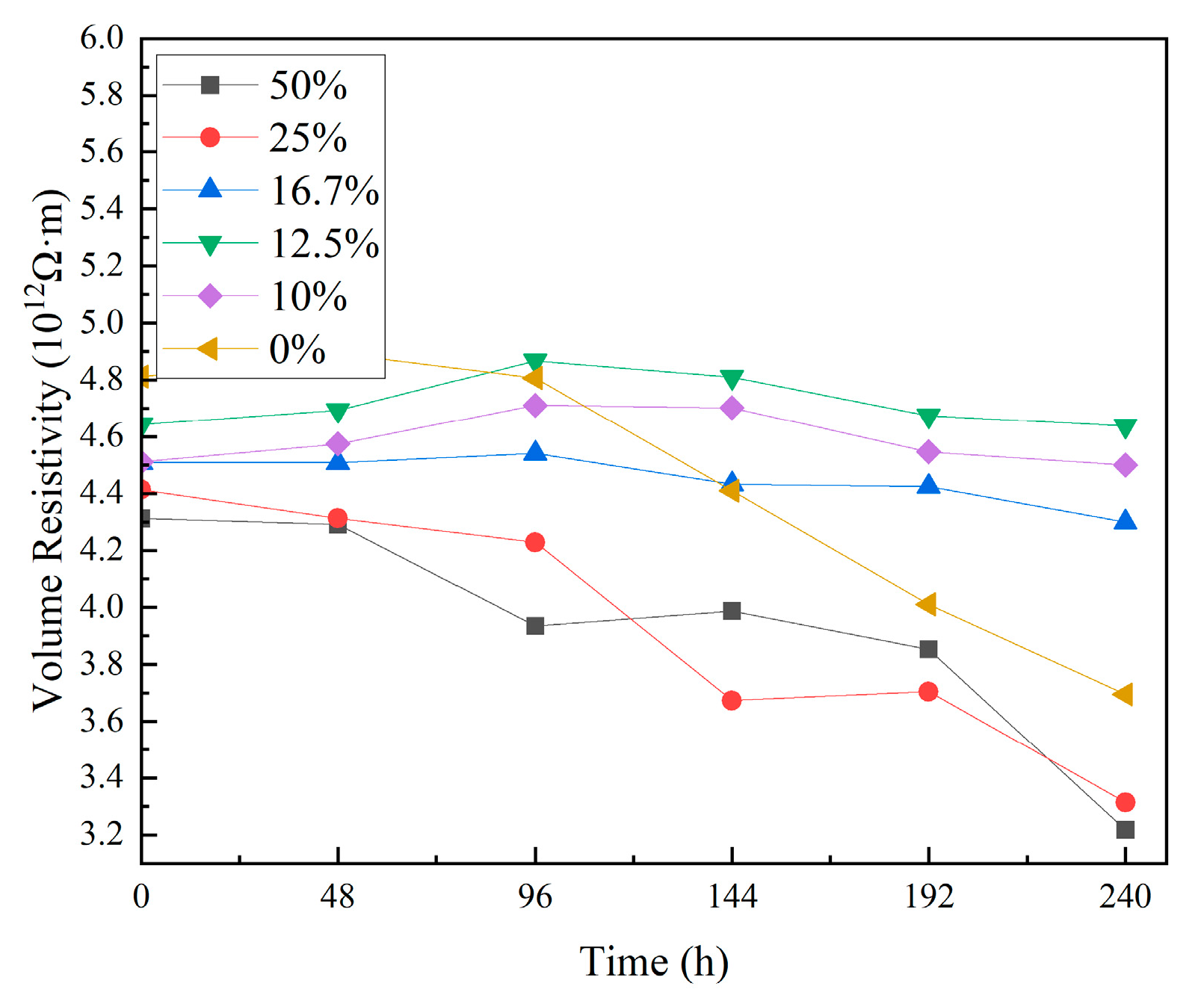

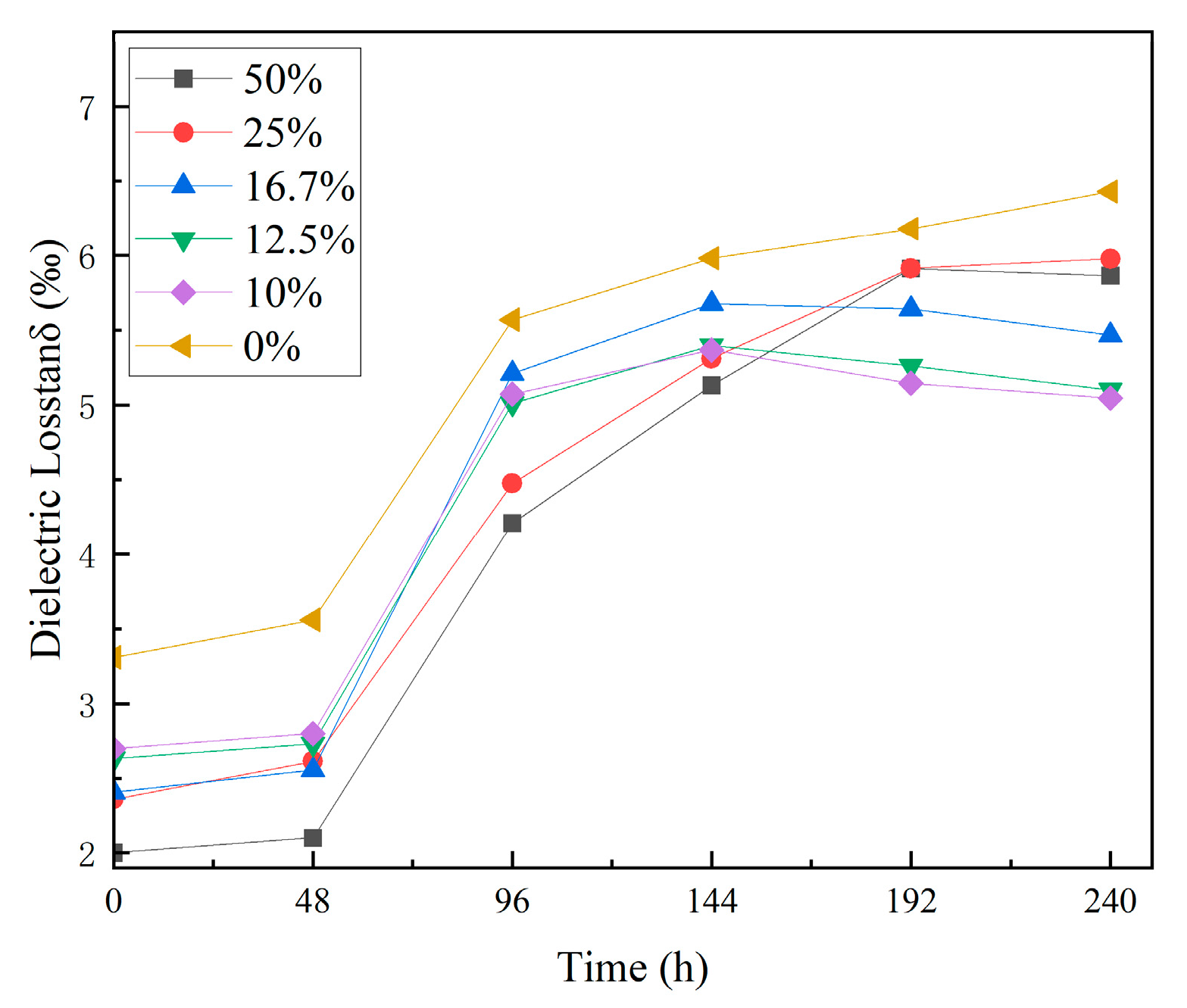
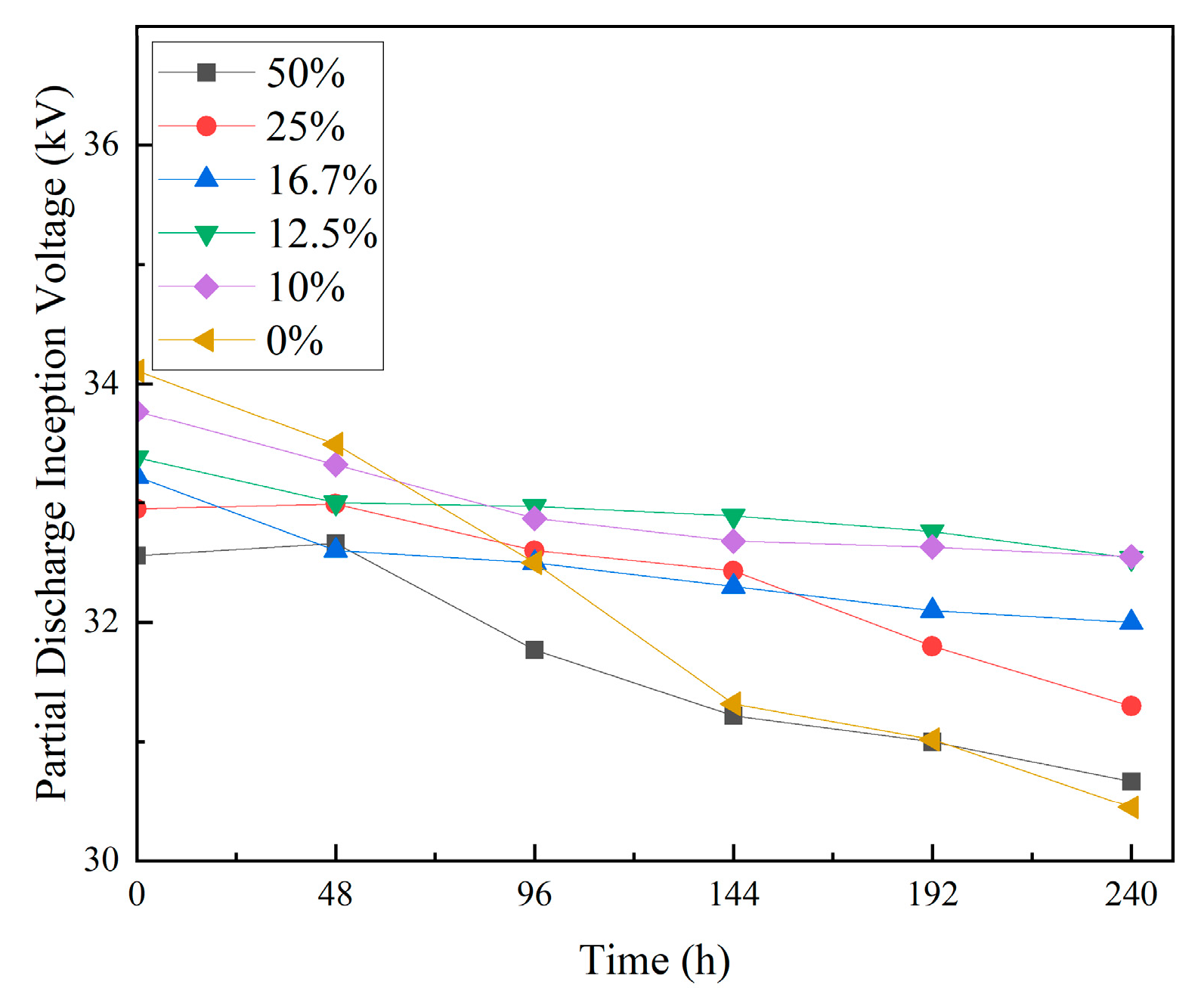

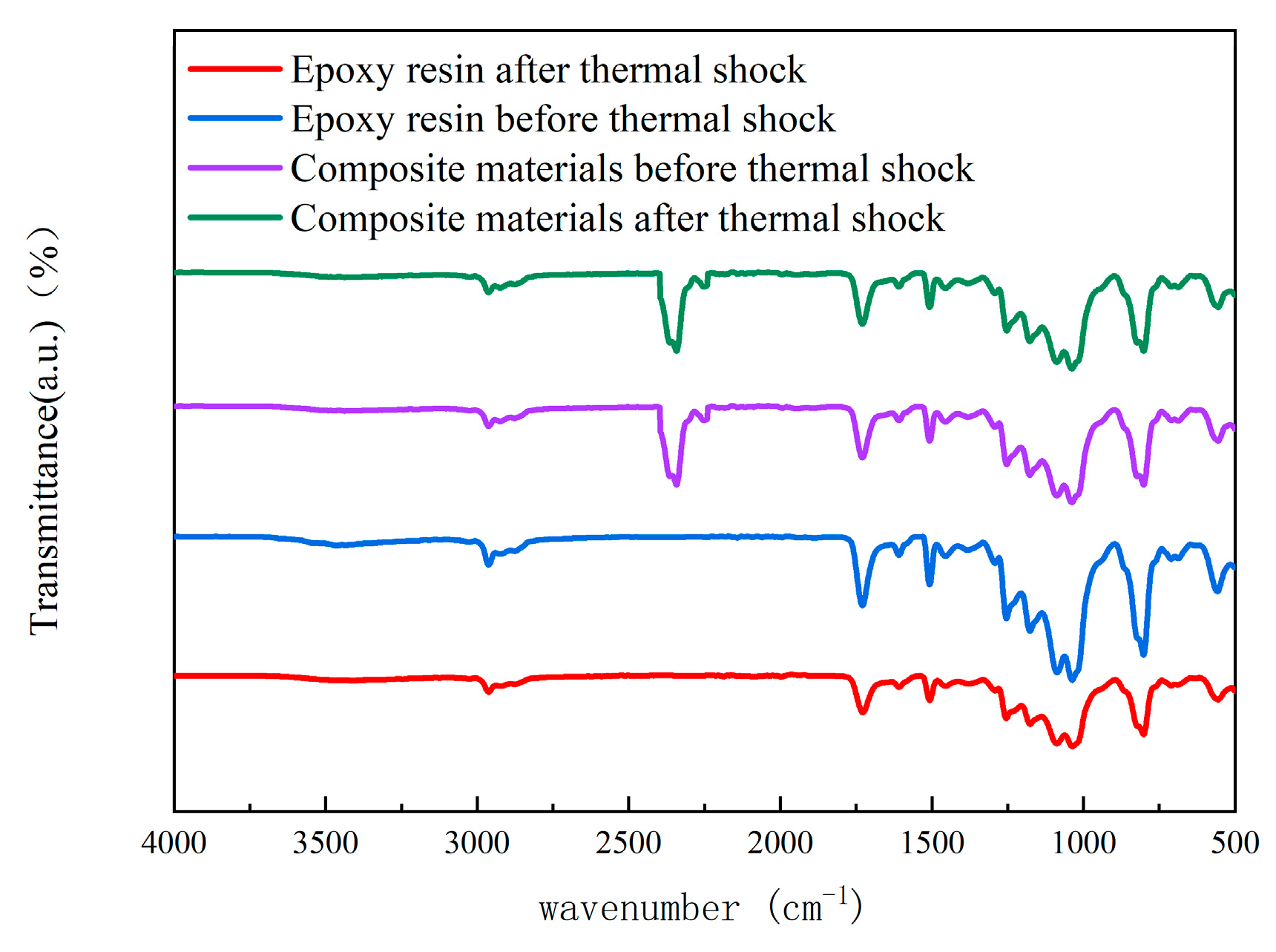
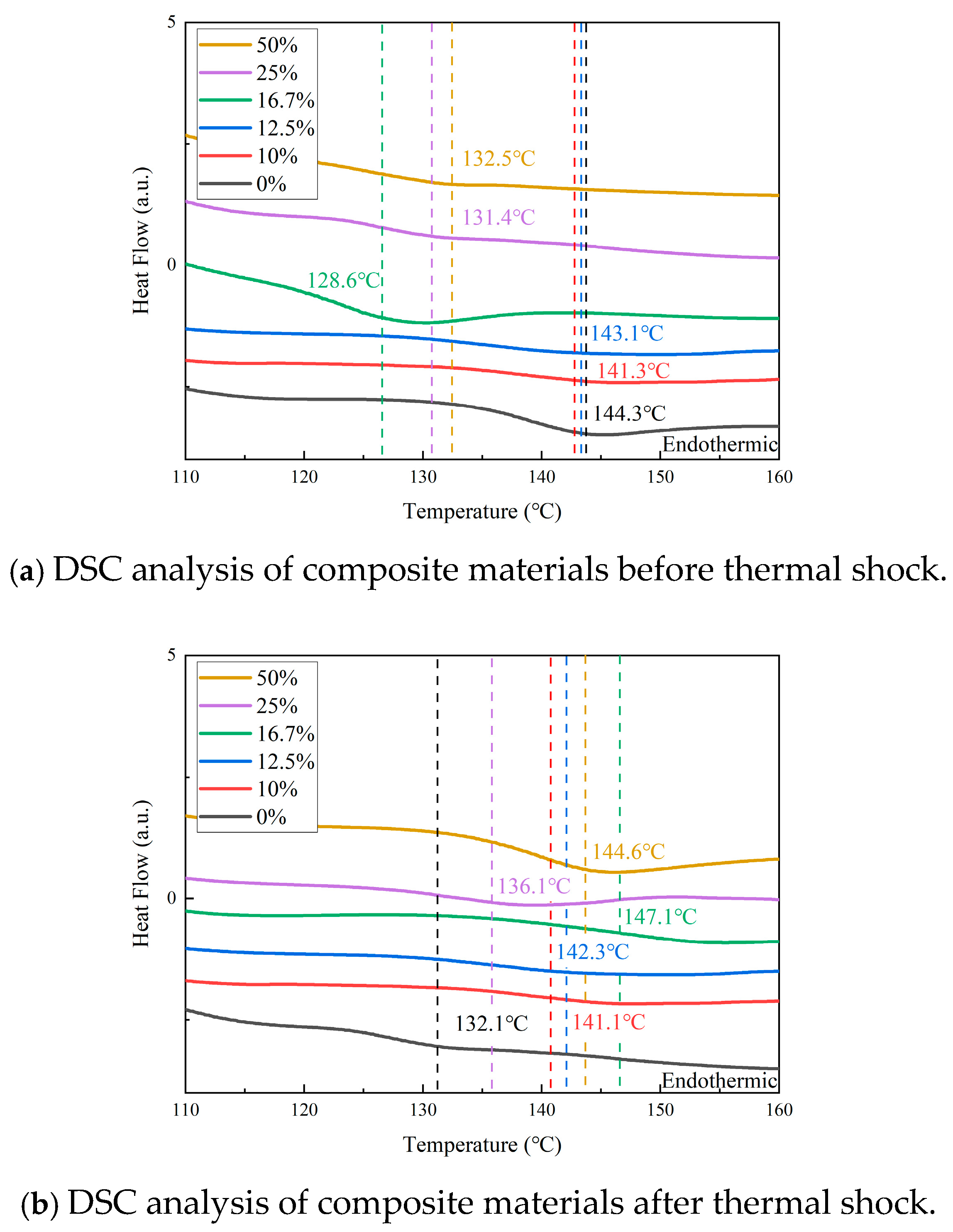
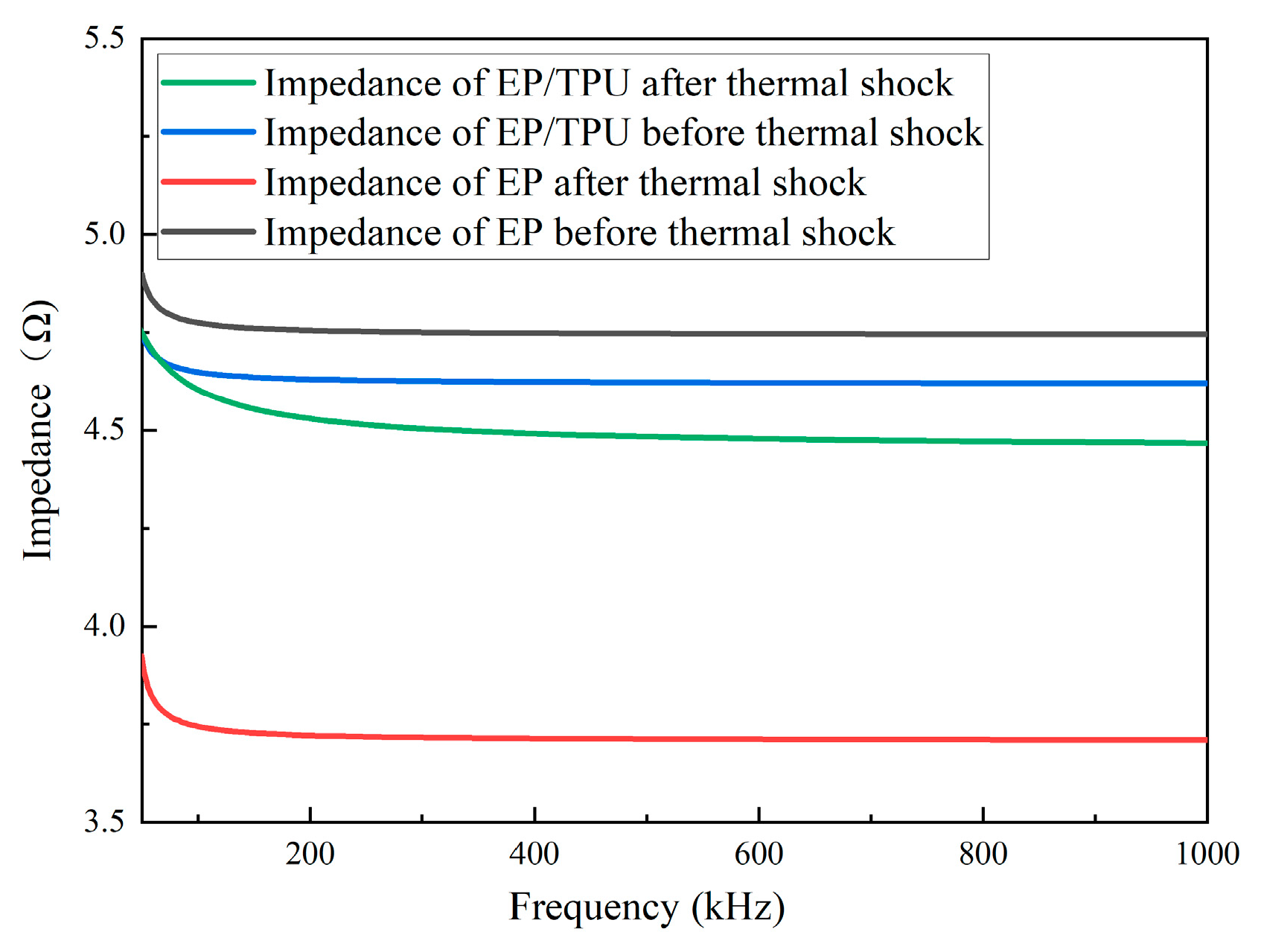





| Raw Material | Manufacturer |
|---|---|
| Bisphenol A EP E-51 | Wuxi Boruiyu Chemical Technology |
| Thermoplastic Polyurethane Elastomer | BASF SE |
| N, N-DMF | Shanghai Pharmaceuticals |
| Methyl Tetahydrophthalic Anhydride | Guangzhou Zhonggao Chemical |
| Toughening Agent DH410 | Jiaxing Dongfang Chemical Plant |
| Accelerator DMP-30 | Jiaxing Dongfang Chemical Plant |
| Anhydrous Ethanol and Other Reagents | China National Pharmaceutical Group Chemical Reagents |
Disclaimer/Publisher’s Note: The statements, opinions and data contained in all publications are solely those of the individual author(s) and contributor(s) and not of MDPI and/or the editor(s). MDPI and/or the editor(s) disclaim responsibility for any injury to people or property resulting from any ideas, methods, instructions or products referred to in the content. |
© 2025 by the authors. Licensee MDPI, Basel, Switzerland. This article is an open access article distributed under the terms and conditions of the Creative Commons Attribution (CC BY) license (https://creativecommons.org/licenses/by/4.0/).
Share and Cite
Yang, G.; Ding, N.; Jiang, C.; Yang, P.; Gao, Q.; He, Y.; Han, L. Investigation of the Insulation Characteristics of TPU/EP Composites Under Cold Thermal Shock. Materials 2025, 18, 1840. https://doi.org/10.3390/ma18081840
Yang G, Ding N, Jiang C, Yang P, Gao Q, He Y, Han L. Investigation of the Insulation Characteristics of TPU/EP Composites Under Cold Thermal Shock. Materials. 2025; 18(8):1840. https://doi.org/10.3390/ma18081840
Chicago/Turabian StyleYang, Guoqing, Nan Ding, Chaolu Jiang, Peizhi Yang, Qingqing Gao, Yichen He, and Lu Han. 2025. "Investigation of the Insulation Characteristics of TPU/EP Composites Under Cold Thermal Shock" Materials 18, no. 8: 1840. https://doi.org/10.3390/ma18081840
APA StyleYang, G., Ding, N., Jiang, C., Yang, P., Gao, Q., He, Y., & Han, L. (2025). Investigation of the Insulation Characteristics of TPU/EP Composites Under Cold Thermal Shock. Materials, 18(8), 1840. https://doi.org/10.3390/ma18081840





